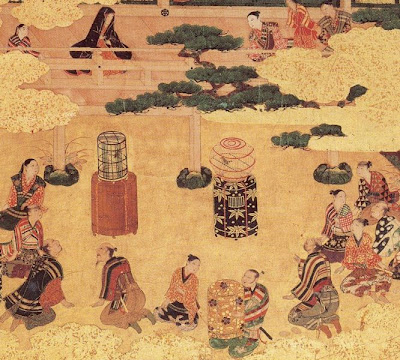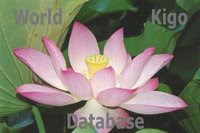:::::::::::::::::::::::::::::::::::::::::::::::::::::::::::::::::::::::::::::::::::::::::::::::::::::
Nirvana Ceremony (Nehan-E 涅槃会 ねはんえ )
***** Location:Japan
***** Season: Early Spring (Feb. 15)
***** Category: Observance
*****************************
Explanation
This is a Buddhist ceremony in memory of the passing away of Shakyamuni, the Buddha, traditionally on the full moon day of the second lunar month, nowadays on the 15th of February (seldom on the 15th of March) in many temples.
There are many more Japanese kigo for this event, I will list just a few more.
Shaka is a common abbreviation for Shakyamuni.
Shaka lying down, ne Shaka 寝釈迦
Nirvana Statue, nehanzoo涅槃像
Nirvana, nehan 涅槃, o-nehan お涅槃(おねはん)
Shaka nemuru, Shaka sleeping 釈迦眠る
..... neshaka ne Shaka 寝釈迦(ねしゃか)
Temple with a Nirvana Ceremony, nehandera 涅槃寺
Painting of a Nirvana Scene, nehanzu 涅槃図
Parting in February, nigatsu no wakare 二月の別れ
Parting of the Buddha, hotoke no wakare 仏の別れ
Buddha leaving, sarishi hotoke 去りし仏
Offering Rice Dumplings from the New Year offerings, mochibana-iri 餅花煎
dangomaki 団子撒き(だんごまき)"throwing dango dumplings"
Buddha's nose excrements, shaka no hana-kuso 釈迦の鼻糞
a thin horse, yase-uma 瘠せ馬
Buddha's Memorial day, bukki 仏忌
sendan no kemuri 栴檀の煙(せんだんのけむり)
smoke of fragrant chinaberry wood
tsuru no hayashi 鶴の林(つるのはやし)"forest with cranes"
kakurin no yowa 鶴林の夜半(かくりんのよわ)"wake of the cranes in the forest"
When Shakyamuni entered nirvana under the Bodhi tree, the tree withered and became white like a crane.
(Some of these kigo are hard to translate in a short English version.)
:::::::::::::::::::::::::::::::::::::::::::::::::::::::::::::::::::::::::::::::::::::::::::::::::::::
observance kigo for mid-spring

yuikyoo gyoo-e 遺敎経会 (ゆいきょうぎょうえ)
last sermon memorial ceremony at temple
Daiho-onji in Kyoto 大報恩寺
This temple has a famous "Buddha hall" Senbon Shakadoo 千本釈迦堂 with 1000 statues.
senbon nenbutsu 千本念仏(せんぼんねんぶつ)
nembutsu ceremony for 1000 statues
kundoku e 訓読会(くんどくえ)"reading the last sutra"
yuikyoo e 遺敎会(ゆいきょうえ) "Legacy Teaching Sutra" memorial
This ceremony is held on the 22 day of the 3rd lunar month. Monks from the temple Chishaku-In 智積院 of Higashiyama are invited, the last scripture of Shaka, the "last preaching sutra, the Yuikyo, is read and Nenbutsu prayers are recited.
ものに恋ひさめぬ寝耳や遺教経
mono ni koi samenu nemimi ya yuikyoogyoo
clinging to things -
the final sermon of Buddha
is not for my ears
Matsuse Seisei 松瀬青々 (1869 - 1937)
:::::::::::::::::::::::::::::::::::::::::::::::::::::::::::::::::::::::::::::::::::::::::::::::::::::
Statues and paintings of Shakyamuni on his death bed are not so common in Japan, but often seen in Thailand and Sri Lanka.
Pilgrims meditating and paying respects at the place of the Buddha's Parinirvana at the Nirvana Temple, Kushinara.
http://www.buddhanet.net/e-learning/buddhistworld/about-pilgrim.htm
xxxxxxxxxxxxxxxxxxxxxxxxxxxxx
Buddha's Life and Pilgrimages to the Holy Places
The earliest centres of Buddhist pilgrimages were the places associated with the life and Teachings of the great Master. These four places are Lumbini, Bodh Gaya, Sarnath and Kusinara. Lumbini, in what is now Nepal, is the birthplace of Gautama Buddha. The others are in India: Bodh Gaya was the place, under the pipal or Bo tree, where the Buddha was enlightened after practising meditation for several years. Sarnath was the scene of His first teaching and Kusinara was the place of His death or final Nirvana.
After the death of the Buddha, the relics of His body were collected from the funeral pyre and divided into eight parts. These were distributed to the claimants and stupas, or burial mounds, were erected on the relics. The practice of pilgrimage in Buddhism probably started with visits to these places, the purpose of which was to achieve personal advantage such as rebirth in a good location, as well as to honour the great master. Thus the custom of pilgrimage has been widespread among Buddhist for many centuries and is common to both the Mahayana and Theravada traditions.
http://www.buddhanet.net/e-learning/buddhistworld/about-pilgrim.htm
xxxxxxxxxxxxxxxxxxxxxxxxxxxxx
Painting of a Nirvana Scene, nehanzu 涅槃図
Some famous temples have a painting of this scene, with the disciples gathered around weeping, animals and all in pain and mourning the passing away.
Painting by Myoson 仏涅槃図_命尊筆

CLICK for enlargement !
英一蝶 Hayabusa Itcho

. . . CLICK here for the full scene !
Painting from The Boston Museum
..................................................................................................
The above painting is from Hooryuu-Ji (Horyuji)
法隆寺の涅槃図
http://www.horyuji.or.jp/nehane.htm
. Nehanzu Haiku from Temple Horyu-Ji
.................................................................................................

Nyanzu にゃハンズ Nyan - I am a cat !
.................................................................................................
Nehan-e Ceremony at Koofuku-Ji Temple in Kyoto
興福寺の涅槃会
At Koofuku-Ji the Nirvana Sutra (Nehan Kyoo) is held in high esteem since the Nara period around 750. The Nirvana Ceremony (Nehan-e) is celebrated here since 860. At this temple the ceremony is also called Jooraku-e 常楽会, another kigo for spring.
The ceremony starts at 10 in the morning, sutras are chanted, sacred music performed and sweet ricewine (amasake) is offered to the people.
http://www.kohfukuji.com/kohfukuji/03_tmpe/ma_sc03.html
.................................................................................................
Temple Sennyuu-Ji, Kyoto 泉涌寺
The Nirvana painting on paper at this temple 大涅槃図 is one of the largest in Japan, 8 m wide and 16 meters long. It weighs 400 kg. It was painted by 明誉古上人 during the middle Edo period.
The ceremony is held on March 15, but the famous painting is shown to visitors from the 14th to the 16th.
Click on スタート to get a slide show of important cultural properties of this temple.
http://www.mitera.org/HTML/GALLERY/INDEX%7E1.HTM
http://www.mitera.org/
http://homepage2.nifty.com/cub/niwa/sennyuji.htm
................................................................................................
Old Woman as Parody of Death of Buddha
Kuniyoshi Utagawa Kuniyoshi
................................................................................................
Offering Rice Dumplings from the New Year offerings
mochibana-iri 餅花煎
The rice dumplings (mochi) that are left over from the New Year offerings are quite hard. They are cut and slightly barbequed (iru 煎る)to be offered to the Buddha and later eaten by the people.
*****************************
Worldwide use
Nehan Statue in Ruan Pabang, Laos
http://guide.travel.goo.ne.jp/e/goo/traveler/nmyumyu/album/10022527/
*****************************
Things found on the way
Saijiki, monthly events in Kyoto
(Japanese only)
http://www.kotobuki-p.co.jp/kankou/3.htm
*****************************
HAIKU
涅槃会や皺手合する数珠の音
Nehan-e ya shiwade awasuru juzu no oto
Nehan Ceremony -
wrinkled hands in prayer and
the sound of rosary beads
Tr. Gabi Greve
. Rosary beads (juzu 念珠、数珠, 誦数) .
Buddha's Nirvana Day —
wrinkled hands together,
the sound of the rosaries
Tr. ?haikupedia
Matsuo Basho, 1694
shortly before his death
- - - - -

source : yamabuki517
Priests passing the "Fence of the Gods" to the inner shrine.
神垣やおもひもかけず涅槃像
kamigaki ya omoi mo kakezu Nehanzoo
within the fence of the shrine -
what a surprise to find
(a statue of) Buddha lying down to die
Written at
. Ise shrine 伊勢神宮 Ise Jingu .
During this time, the distinction between Buddhist temple and Shinto shrine was not so distinct and many religious places housed both.
This hokku was written on the 15th day of the second lunar month, the ceremony for the Nehan Buddha.
kamigaki 神垣 fence of a shrine, "Fence of the Gods"
. Matsuo Basho 松尾芭蕉 - Archives of the WKD .
:::::::::::::::::::::::::::::::::::::::::::::::::::::::::::::::::::::::::::::::::::::::::::::::::::::::
- - - - - Kobayashi Issa - - - - -
相伴に我らもごろり涅槃哉
shooban ni warera mo gorori nehan kana
let us also lie down
and recline like Buddha -
Nirvana Ceremony
Tr. Gabi Greve
. . . . .
死花をぱっと咲せる仏哉
shini hana wa patto sakaseru hotoke kana
dead flowers suddenly
are made to bloom ...
The Buddha!
This haiku refers (obscurely) to the Second Month, 15th Day festival of Buddha's Death Day, commemorating Gautama Buddha's entrance into nirvana (i.e., his death).
Tr. and Comment: David Lanoue
. . . . .
juzu kakete yamabato narabu nehan kana
doves with prayer beads
in line waiting for
nirvana
Tr. Chris Drake
. Comment by Chris Drake .
:::::::::::::::::::::::::::::::::::::::::::::::::::::::::::::::::::::::::::::::::::::::::::::::::::::
涅槃図の貝いかにして来たりけむ
nehanzu no kai ika ni shite kitari kemu
the shell on the Nehanzu -
I wonder how it came
to be there ?
Ozawa Minoru 小澤實 (1956 - )
:::::::::::::::::::::::::::::::::::::::::::::::::::::::::::::::::::::::::::::::::::::::::::::::::::::
人体に蝶のあつまる涅槃かな
on the human body
butterflies are assembling -
Nirvana Festival
Kakimoto 柿本多映
http://www.haiku-data.jp/kigo_work_list.php?kigo_cd=271
xxxxxxxxxxxxxxxxxxxxxxxxxxxxxxxxxxxxxxx
at 一畑山薬師寺 Temple Yakushi-Ji, Aichi, Okasaki town
涅槃図をあふるる月のひかりかな
nehanzu o afururu tsuki no hikari kana
suffused in moonlight ––
image of the Buddha
entering Nirvana
Tr. Abigail Freeman
. Kuroda Momoko 黒田杏子 .
The cut marker KANA is at the end of line 3.
:::::::::::::::::::::::::::::::::::::::::::::::::::::::::::::::::::::::::::::::::::::::::::::::::::::
山の湯のなみなみとある寝釈迦かな
the hot water from the well
is pooring out steadily -
Nirvana Ceremony
桂信子
http://www.haiku-data.jp/kigo_work_list.php?kigo_cd=271
xxxxxxxxxxxxxxxxxxxxxxxxxxxxxxxxxxxxxxx
涅槃会の仏の足の方へ寄る
Nirvana Ceremony -
people are assembling
at the feet of the Buddha
森田智子
http://www.haiku-data.jp/kigo_work_list.php?kigo_cd=271
xxxxxxxxxxxxxxxxxxxxxxxxxxxxx
涅槃 Nehan
涅槃像あかき表具も目にたゝず 沾圃
山寺や猫守り居るねはむ像 不撤
貧福のまことをしるや涅槃像 山蜂
ねはん会や皺手合る珠数の音
Nehan-e ya shiwa-de awaseru juzu no oto
Nehan Ceremony-
wrinkled hands in prayer and
the sound of rosary beads
Matsuo Basho 芭蕉
http://www.j-texts.com/kinsei/h7buah.html
xxxxxxxxxxxxxxxxxxxxxxxxxxxxxxxxxxxxxxx
Nirvana Temple
the meditating pilgrims
and your eyes
paying respects
in the holy temples
teaching silence
Geert Verbeke
:::::::::::::::::::::::::::::::::::::::::::::::::::::::::::::::::::::::::::::::::::::::::::::::::::::
nirvana ceremony ~
a butterfly buddha flutters
among human buddhas
reclining Buddha ~
a little fly settles on
his closed eye
nirvana ceremony ~
the maitreya buddha
watches his children
Narayanan Raghunathan
India, September 2009
*****************************
Related words
***** West Wind on the Day of the Nirvana Ceremony,
nehan nishi 涅槃西風
オムレツの腰がきまらぬ涅槃西風
坂本敏子
涅槃西風ねむりいろなる珊瑚彫る
井沢唯夫
http://www.haiku-data.jp/kigo_list.php?season_cd=1
:::::::::::::::::::::::::::::::::::::::::::::::::::::::::::::::::::::::::::::::::::::::::::::::::::::
Reference:
WKD
Saijiki for Buddhist Ceremonies
:::::::::::::::::::::::::::::::::::::::::::::::::::::::::::::::::::::::::::::::::::::::::::::::::::::
Wakare - Parting with friends
. Matsuo Basho 松尾芭蕉 - Archives of the WKD .
[ . BACK to WORLDKIGO TOP . ]
[ . BACK to DARUMA MUSEUM TOP . ]
- ##nehan #nehanzu -
:::::::::::::::::::::::::::::::::::::::::::::::::::::::::::::::::::::::::::::::::::::::::::::::::::::






























